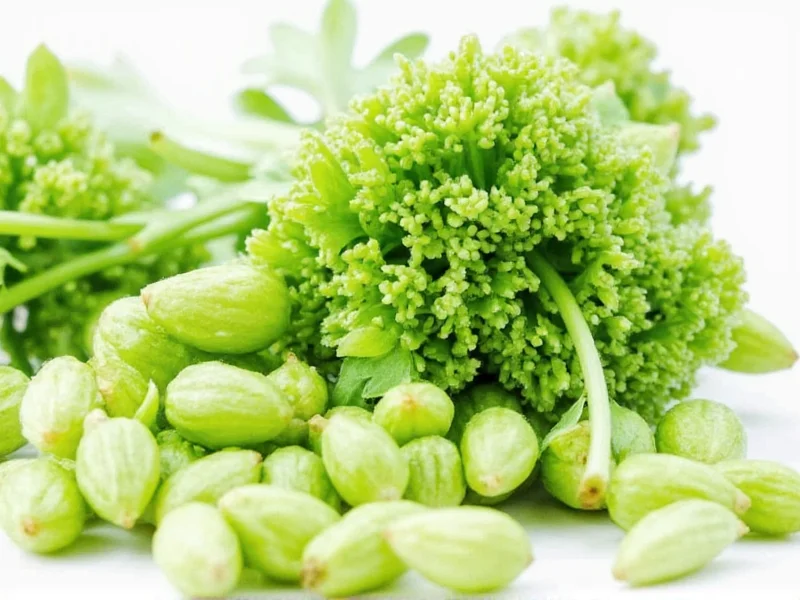When you first encounter celery seeds, you'll notice their flavor is significantly more potent than the mild stalks most people are familiar with. These tiny seeds pack a powerful punch that's both familiar and surprisingly complex. Unlike the subtle, watery taste of fresh celery, celery seeds deliver a concentrated essence that's simultaneously herbal, warm, and slightly pungent.
The Complete Flavor Profile of Celery Seeds
Celery seeds contain concentrated levels of apiole and limonene, the compounds responsible for celery's distinctive flavor. This concentration creates a multi-dimensional taste experience:
- Primary notes: Earthy, herbal, with distinct celery character
- Secondary notes: Subtle bitterness, warm spice, mild pepperiness
- Aromatic qualities: Intense celery fragrance with citrus undertones
- Mouthfeel: Slight oiliness that carries the flavor across the palate
- Aftertaste: Lingering herbal note with a clean finish
Professional chefs often describe celery seeds as having "celery on steroids"—the familiar flavor but amplified and with additional complexity. The bitterness is present but balanced, never overwhelming when used in appropriate quantities.
Celery Seeds vs. Fresh Celery: A Flavor Comparison
Understanding the difference between celery seeds and fresh celery is crucial for proper culinary application. While they come from the same plant (Apium graveolens), their flavor profiles differ significantly:
| Characteristic | Celery Seeds | Fresh Celery Stalks |
|---|---|---|
| Flavor intensity | Very strong (use sparingly) | Mild (can be used generously) |
| Bitterness level | Moderate to pronounced | Very mild or none |
| Aromatic strength | Intensely fragrant | Subtly fragrant |
| Warmth/spice | Noticeable warmth | Cooling effect |
| Best culinary uses | Seasoning blends, pickling, soups, stews | Raw consumption, salads, juicing |
Culinary Applications of Celery Seed Flavor
The unique taste profile of celery seeds makes them invaluable in specific culinary contexts. When exploring what does celery seed taste like in recipes, consider these applications:
Pickling and preserving: Celery seeds are a staple in pickling spice blends because their robust flavor holds up well in vinegar-based solutions. The slight bitterness balances the sweetness in pickles, creating a more complex flavor profile than fresh celery could provide.
Soup and stew seasoning: In liquid-based dishes that cook for extended periods, celery seeds maintain their flavor integrity better than fresh celery, which can become muted. The seeds' concentrated flavor penetrates broth effectively, providing consistent celery essence throughout the dish.
Spice blends and rubs: When creating dry rubs for meats or vegetable seasoning blends, celery seeds contribute both flavor and texture. Their slight oil content helps other spices adhere to food surfaces while delivering that distinctive celery note.
For those wondering how does celery seed taste compared to celery salt, the primary difference is intensity and sodium content. Celery salt combines ground celery seeds with salt (typically in a 3:1 ratio of salt to seeds), diluting the seed's complex flavor profile while adding significant sodium. Pure celery seeds offer more nuanced flavor control for discerning cooks.
Maximizing Celery Seed Flavor in Your Cooking
To best utilize celery seeds' distinctive taste, consider these professional techniques:
Toasting for enhanced flavor: Lightly toasting celery seeds in a dry pan before use intensifies their aromatic compounds. Heat them over medium-low heat for 1-2 minutes until fragrant, being careful not to burn them, which would create unpleasant bitterness.
Grinding for even distribution: Whole celery seeds can sometimes create uneven flavor pockets in dishes. For uniform flavor distribution, especially in dressings or fine-textured dishes, grind the seeds using a spice grinder or mortar and pestle.
Timing of addition: Add celery seeds early in the cooking process for soups and stews to allow their flavor to fully integrate. For salads or finishing touches, add them later to preserve their brighter top notes.
When substituting for fresh celery, remember that what is the taste ratio of celery seed to fresh celery is approximately 1 teaspoon of seeds for every 1-2 stalks of fresh celery, depending on the recipe and desired intensity.
Storage Tips for Preserving Flavor
Celery seeds' flavor compounds are volatile and degrade over time. To maintain their distinctive taste profile:
- Store in an airtight container away from light and heat
- Keep in a cool, dark cupboard (not above the stove)
- Use within 1 year for optimal flavor (though safe indefinitely)
- Freeze for long-term storage (up to 2 years)
Freshness dramatically impacts how does celery seed taste when old versus fresh. Stale seeds lose their aromatic complexity and develop a flat, one-dimensional bitterness. Properly stored fresh seeds should have a vibrant greenish-brown color and release a strong celery aroma when crushed between your fingers.
Substitutes When Celery Seed Isn't Available
If you're curious about what tastes similar to celery seed when it's not in your pantry, consider these alternatives:
- Fennel seeds: Share similar herbal notes with a sweeter profile
- Dill seeds: Offer comparable earthiness with more pronounced anise notes
- Lovage: Provides the closest flavor match but is harder to find
- Celery leaves: Fresh or dried, though much milder in flavor
Each substitute alters the final dish's flavor profile, so choose based on what aspect of celery seed flavor you're trying to replicate—whether it's the earthiness, the herbal quality, or the subtle bitterness.











 浙公网安备
33010002000092号
浙公网安备
33010002000092号 浙B2-20120091-4
浙B2-20120091-4